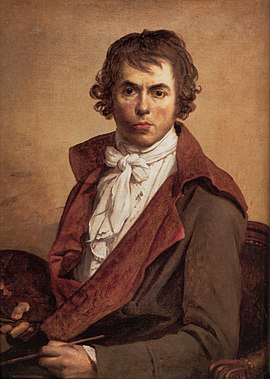User:Canned Meats/sandbox
| Self-Portrait | |
|---|---|
 | |
| Artist | Jacques-Louis David |
| Year | 1794 |
The Self-portrait is a self-portrait painted by the artist Jacques-Louis David in 1794 whilst in prison at the Hôtel des Fermes for having supported the robespierristes. It was his third and last self-portrait - the second was the 1791 Aux trois collets (Uffizi, Florence). He gave this self-portrait it to his former student Jean-Baptiste Isabey and it later then entered the collections of the Louvre in 1852 (inv. 3705).
Description
[edit]
The painting represents the artist facing himself, The bust, in three-quarters, is on a yellow-gray plain background. David is dressed in a dark overcoat with wide chestnut lapels and a white shirt, tied with a scarf of the same color. In his left hand he holds a brush, in the right a palette. He is seated on an armchair, the back of which can be seen. The figure is illuminated from the right. David depicts himself staring directly at the viewer which is a byproduct of David using a mirror to create the portrait. The use of the mirror also affects other aspects of the painting like the positioning of the hands. David was right-handed, yet in the portrait it is his left hand which holds his brush and his right hand which holds his palette, opposite for what right-handed artists typically prefer. Similarly, the tumor on David's cheek, which was caused by a fencing injury, is shown to be on his right cheek in the portrait, but in reality was on his left cheek. The tumor is also partly obscured by shadow.
Because the portrait was painted from a mirror image, the positions of the hands are reversed; David does not correct this detail, which shows him holding the paintbrush in his left hand, although he is right-handed; similarly, the tumor that affects his left cheek is found on the right but is hidden in shadow.
David represented himself as a young man, which he is no longer since he was 46 when he painted this painting. This can be seen when compared to a self portrait David painted three years earlier. I
Context
[edit]David was an active member of the Jacobins and was close friends with Robespierre. On July 27 1794, When the Thermidorian Coup took power, David escaped execution due to his absence from the National Assembly at the time.[1] However, Robespierre and many of his followers who were present in the National Assembly at the time were arrested and executed by guillotine the next morning. David was captured and arrested shortly after on August 2 of the same year due to his affiliation and support of Robespierre and the revolutionaries. David was imprisoned in the Hôtel des Fermes on the same day as his arrest and on the way was accompanied by his pupil Pierre-Maximilien Delafontaine who also provided David with the mirror he used to paint his self portrait[2].
Analysis
[edit]David only ever painted three self portraits with this one being the last one he would ever paint. David would never publicly display any of his self portraits and ended up giving this portrait to his his pupil Jean-Baptiste Isabey.[1][2] This suggests that the creation of self portraits to David was an exercise in self identity and reflection. His arrest and the execution of Robespierre along with his followers marked the end of David's political career and due to his more active role in the previous regime, David may have felt a need to revaluate his own identity.
In this painting, David chose to depict not only his bust, but also his hands holding a brush and palette. It is said that this may have been a strategic move by David to avoid execution by reinforcing his identity as a painter over a political activist. This theory is supported by David's decision to depict a younger version of himself with rosy cheeks, messy hair, and in a romantic style to push the idea that he is a simple naïve painter.[3] David's depiction of his face and expression invokes a sense of cluelessness and lack of awareness assuring the viewer that while David did take political action, he lacked of foresight and goals.[4]
Some scholars point out the way David depicted the tumor on his face. Particularly the way it splits his face asymmetrically
 | This is a user sandbox of Canned Meats. You can use it for testing or practicing edits. This is not the sandbox where you should draft your assigned article for a dashboard.wikiedu.org course. To find the right sandbox for your assignment, visit your Dashboard course page and follow the Sandbox Draft link for your assigned article in the My Articles section. |
- ^ a b Lajer-Burcharth, Ewa (1999). Necklines: the art of Jacques-Louis David after the Terror. New Haven [Conn.] London: Yale university press. ISBN 978-0-300-07421-5.
- ^ a b Bordes, Philippe (2005). Jacques-Louis David: Empire to exile. New Haven, Conn: Yale University Press. ISBN 978-0-300-10447-9.
- ^ Gotlieb, Marc J.; Crow, Thomas (1996-06). "Emulation: Making Artists for Revolutionary France". The Art Bulletin. 78 (2): 362. doi:10.2307/3046181. ISSN 0004-3079.
{{cite journal}}: Check date values in:|date=(help) - ^ Cooper, Douglas (1948). "Jacques-Louis David: A Bi-Centenary Exhibition". The Burlington Magazine. 90 (547): 277–280. ISSN 0007-6287.
